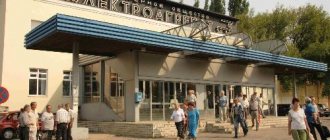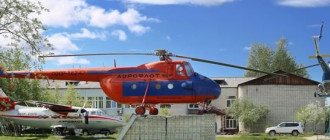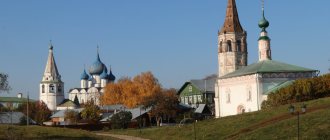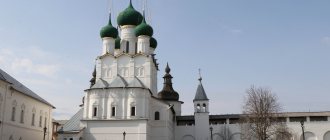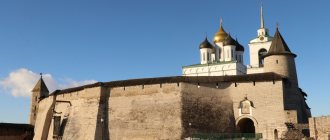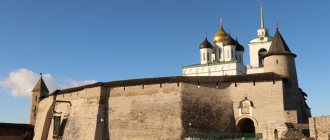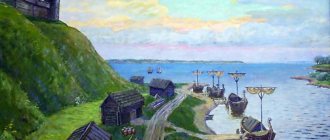The first thing a person who comes to Chaplygin by train sees is the inscription “Ranenburg” on the railway station building. Over the years, the old name of the city has not been forgotten and now coexists with the new one almost on equal terms. The local newspaper is called "Ranenburg Bulletin", there is a shopping center in the city center, and tourism in the city and region is entirely built on the historical past. In 2006, a referendum was even held in Chaplygin on returning the historical name, but supporters of this idea were defeated.
Photo: Sofya Urmancheeva
Story
Chaplygin is located in the Lipetsk region, about a five-hour drive from Moscow. It owes its original name to the fortress from the time of Tsar Peter.
In the 17th century, a small village appeared on the site of the future city. In 1695, a wooden traveling house was built here for Peter I, in which the Tsar stayed on his way from Moscow to the south. In 1702, he built a fortress near the village and named it Oranienburg. The owner of these territories was Peter's friend, Prince Alexander Menshikov. Over time, the name of the fortress extended to the settlement. Over the course of several decades, the name Oranienburg was shortened to Raninburg, and in 1778, Empress Catherine II declared the village the district town of Ranenburg, with an “e”. Local residents were actively involved in trade, and in the 19th century Ranenburg became a wealthy merchant town. In 1890, a railway station of the same name was built here.
1 / 2
Ranenburg, 1917 / Photo from the archives of the Chaplyginsky Museum of Local Lore
2 / 2
Photo from the archives of the Chaplyginsky Museum of Local Lore
A huge number of settlements were renamed in the USSR. More than 250 cities and villages across the country were named in honor of Lenin alone. The Soviet government got rid of most German-language and German-sounding names, and in 1941 the Autonomous Soviet Socialist Republic of Volga Germans was abolished, and dozens of its colonies received new names. After the war, there was a broad campaign to rename settlements in the part of the territory of East Prussia that was transferred to the Soviet Union, which became the Kaliningrad region. In 1948, Ranenburg also lost its name. It was renamed Chaplygin in honor of the mechanical physicist Sergei Chaplygin, who was born in the city in 1869.
The city respects its own history. Photographs of pre-revolutionary Ranenburg and its inhabitants have been preserved; they are regularly published in the LiveJournal “Notes of a Ranenburger”. In 2004, the city restored one of the fortress buildings - the house of Alexander Menshikov. Now it houses a local history museum. The house numbers in the center of Chaplygin show two street names: the official current one and the pre-revolutionary one. A few kilometers from the city, the Peter and Paul Monastery, a monastery founded by Prince Menshikov and ruined by the Bolsheviks, has been restored for years.
Historical Museum
A popular place in the city is the Historical Museum. As the name suggests, this is a museum. It was built on an area near a fortress called Oranienburg. As we know from history, Peter 1 himself gave this fortress to Menshikov for his services. And that is why this place is often called the Menshikov House and the museum was built here.
In the historical museum you can find which famous people lived here, as well as a lot of information that tells the history of the fortress, as well as its role, because as is known, the fortress greatly helped in the development of the city and left a big mark on history.
The museum also hosts various exhibitions. So for history buffs or simply for those who are interested in the history of the city, I highly recommend visiting this Historical Museum.
Location: Sovetskaya street - 43.
Referendum
In 2006, a referendum was held in Chaplygin on returning the historical name to the city. The main initiator of the project was the late Yuri Telyakov, at that time the head of the local council of deputies and director of the Chaplyginsky starch plant. If supporters of the return of Ranenburg had won, the city would have become the fifth Russian “burg” along with St. Petersburg, Yekaterinburg, Orenburg and Shlisselburg. All of them also lost their historical names during the Soviet years, and then were renamed back.
But the majority of the townspeople who came to the polling stations were in favor of preserving the name Chaplygin, and the referendum itself was declared invalid due to low turnout. 37% of its participants voted for the historical name. “Our main mistake was that we were unable to coordinate our actions. It was all swan, crayfish and pike, everyone had their own opinion. The joint work did not work out, and because of this there was no uniform information dump,” says one of the members of the referendum initiative group, local historian Alexander Bogdanov. Due to internal disputes, the authors of the project were unable to convince the townspeople that the name should be returned. In addition, the head of the Chaplygin administration did not support the idea of returning the name Ranenburg, and, according to Bogdanov, the administrative resource worked against their team.
Merchant Museum
A very interesting museum that you should definitely visit. Despite the fact that the museum opened quite recently, a lot of people, not only locals, but also many foreigners, visited it.
The museum itself consists of two parts. The first part contains exhibitions and stands with various items of that time. On the second part of the museum there is a copy of a real merchant's house. Everyone will have the opportunity to look at how life used to be. Anyone can look at antique dishes and furniture and clearly see how and in what houses the merchants of that time used to live.
Location: Sovetskaya street - 78.
Tourist Ranenburg
The peculiarity of Chaplygin is that its main attraction, the Peter the Great fortress of Ranenburg, has not survived to this day. A model of the fortification can be seen on the ground floor of the local history museum. Even a photograph from the end of the 19th century has survived, in which some of the fortress’s buildings are visible. A schematic image of its bastions adorns the flag of the Chaplyginsky district. Today, a city park is located on the site of the complex.
1 / 3
Photo: Sofya Urmancheeva
2 / 3
Photo: Sofya Urmancheeva
3 / 3
Photo: Sofya Urmancheeva
Alexander Bogdanov believes that returning the city to its former name would allow, in particular, to raise money for the development of the fortress: “The Ranenburg fortress would be an iconic tourist attraction if it were restored. But it can be restored, and there was a conversation about this.”
Director of the Chaplyginsky Tourism Center Valentina Povaluka also notes the importance of returning the old name to “continue the promotion of Ranenburg as Peter’s fortress, the first in Russia, built according to all the rules of European fortification.” Thanks to the development of tourism in the region in recent years, the word “Ranenburg” has practically become a tourist brand. “In the development of tourism, the Chaplyginsky district relies on its rich historical past, so it was decided to promote the old name of the city in advertising articles and events,” says Povaluka.
Today the city is in a situation where the two names actually coexist on equal terms. Every year the city hosts the culinary festival “Ranenburg Feast” and the winter holiday “Vivat, Ranenburg!” Not far from the station there is a steam locomotive monument on which is written “All roads lead to Ranenburg.” One of the key tourism projects in the region has become the Oranienburg autotourism cluster. It was part of the federal target program for the development of domestic tourism in Russia, but was excluded from it in 2016.
Assumption Cemetery Church
The Assumption Cemetery Church was built in 1731 with money from residents of the city of Chaplygin. Currently closed as it is in serious condition and is a historical monument.
The Assumption Cemetery Church is a stone church with a bell tower. I think it’s worth a visit just for fun.
Krivopolyanye
We just have to get acquainted with the nearest suburbs of Chaplygin.
You should definitely visit the village of Krivopolyanye with its Church of the Archangel Michael - it is located southwest of the city, on the road to Lipetsk, and is the same age as Slobodsky. The “church place” is mentioned in it already in the Scribe books of 1638-1639. The ancient wooden St. Michael the Archangel Church, sold to the Peter and Paul Hermitage, was replaced by a stone church - it was built in 1789-1805. The temple is made in the Baroque style - it is an octagon on a quadrangle with a faceted dome and a dome on a small drum. An extensive refectory connects it with a two-tier bell tower, which, judging by its forms characteristic of classicism, was the last to be built.
In the Soviet era, the Krivopolyanskaya church turned out to be the most resistant to ideological pressure - the authorities managed to close it only in 1938, but six years later it was returned to the believers. For quite a long time, the church remained the only functioning temple in the Chaplyginsky district. Until 2005, this church kept the miraculous copy of the Tikhvin Icon of the Mother of God, handed over in the mid-19th century by sisters A.P. and E.P. Bunin to the Ranburg Peter and Paul Monastery. Now he again resides in the Peter and Paul Monastery. That's where we'll go now.
St. Nicholas Church
The history of the temple begins in the nineteenth century in the city of Chaplygin, then it was still called Ranenburg. In this century, the construction of various stone structures began, and at this time the construction of the Church of the Holy Trinity began.
The merchant Ignatius Kalashnikov proposed building a stone church and allocated money for it, but a little later he dies. Ownership passes to his son Leonty Kalashnikov. His father’s idea was approved and the church was built anyway.
Then the church served as a garment factory and then was completely abandoned. But then everything changed. There was long and painful work to erect the temple. All the rubbish was removed, the windows were restored, and those who helped financially were also found. The temple was completely restored and regained its original appearance. Now she decorates the whole city with her appearance. Locals highly recommend tourists to visit this wonderful temple.
Location: Gorky street - 13.
Church of St. Nicholas the Wonderworker
Near the Trinity Cathedral, behind the Trade Rows, we turn right onto Sverdlova Street (formerly Ezzhuya), then left onto Krupskaya Street. Once upon a time this street was called Bolshoi - for its “duration”.
At the intersection with Gorky Street (formerly Ryazanskaya) there is another St. Nicholas Church. Before the revolution, it was urban, while Zarechensky was suburban; Nowadays, in order to distinguish them, the clarification “in Zarechye” is added to the name of the latter. The city St. Nicholas Church is “made up” to look like an ancient Russian building, but it was erected in the late 1850s, when eclecticism came into fashion, borrowing forms from a wide variety of eras, including from the era of Ancient Rus'. From it are false zakomaras, kokoshniks, arcature belts, a powerful apse, and the characteristic shape of a five-domed structure. Looks elegant.
The church was erected in 1850-1855 - like its namesake in Zarechensk, with merchant funds. According to surviving documents, this church “is a stone building, with the same bell tower, built at the expense of the hereditary honorary citizen Ignatius Leontyevich Kalashnikov. There was no arable or estate land at the church, and the houses of the clergy members were located on their own estates.” The city St. Nicholas Church was one of the first to be closed after the revolution - already in the 1920s the building was occupied by a youth club. In 1930, the bells were poured “on tractors” in a race (a socialist competition was announced!) with the communists of Dankov and Kozlov, who were destroying churches at home. The club handed over the building to a garment factory, which was later replaced by a dye shop and warehouse. It is clear that St. Nicholas Church has faced modern times in a depressing state. But - to the survivors. Nowadays it has been put in order and services are held in it.
County species
Let's walk a little along Krupskaya Street, there are many preserved old houses and mansions. Some are simply beautiful, some have architectural value, some have memorial value.
Let's stop at house number 46. Before us is a cozy wooden mansion with windows decorated with carved frames and a cornice accentuated with wooden ligature. There is a sign on the wall: “Museum “House of Nikitin N.P.”.” In this house, which belonged to the wealthy merchant family Nikitin, the outstanding Russian geographer Nikolai Pavlovich Nikitin (1893-1975) was born and raised. After graduating from the Petrovsky Agricultural Academy, he was engaged in scientific and teaching activities. His first books are dedicated to his native land: “Production of agricultural products in the Ranenburg district of the Ryazan province” (1919), “Several pages from the history, geography, statistics of the Ranenburg district of the Ryazan province” (1919), “Statistical and economic description of the volosts of the Ranenburg district of the Ryazan province” (1920). Turning to the Ranburg theme was conceptual for the young researcher, he wrote: “Only by studying your little corner, by studying every blade of grass, every tree, every stream, every hill of your native county, can you really build material and spiritual culture... Only by studying the past and present of your native corner, you can create the future.” Generally speaking, it is Nikitin who stands at the origins of local local history, and in this sense, the creation in Chaplygin of a memorial museum dedicated to the scientist is a sign of gratitude to the famous fellow countryman, a tribute to his memory.

